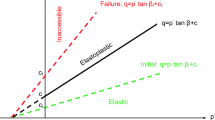Abstract
The paper presents advances in the discrete element modelling of underground excavation processes extending modelling possibilities as well as increasing computational efficiency. Efficient numerical models have been obtained using techniques of parallel computing and coupling the discrete element method with finite element method. The discrete element algorithm has been applied to simulation of different excavation processes, using different tools, TBMs and roadheaders. Numerical examples of tunnelling process are included in the paper, showing results in the form of rock failure, damage in the material, cutting forces and tool wear. Efficiency of the code for solving large scale geomechanical problems is also shown.






Similar content being viewed by others
References
Cundall PA, Strack ODL (1979) A discrete numerical method for granular assemblies. Geotechnique 29:47–65
Campbell CS (1990) Rapid granular flows. Annu Rev Fluid Mech 2:57–92
Karypis G, Kumar V (1998) A fast and high quality multilevel scheme for partitioning irregular graphs. SIAM J Sci Comput 20:359–392
Mustoe G (ed) (1992) Eng Comput 9(2). Special issue
Oñate E, Rojek J (2004) Combination of discrete element and finite element methods for dynamic analysis of geomechanics problems. Comput Methods Appl Mech Eng 193:3087–3128
Rojek J (2007) Modelling and simulation of complex problems of nonlinear mechanics using the finite and discrete element methods (in Polish). Habilitiation Thesis, Institute of Fundamental Technological Research Polish Academy of Sciences, Warsaw
Rojek J, Oñate E, Zarate F, Miquel J (2001) Modelling of rock, soil and granular materials using spherical elements. In: 2nd European conference on computational mechanics ECCM-2001, Cracow, 26–29 June
Williams JR, O’Connor R (1999) Discrete element simulation and the contact problem. Arch Comp Meth Eng 6(4):279–304
Xiao SP, Belytschko T (2004) A bridging domain method for coupling continua with molecular dynamics. Comput Methods Appl Mech Eng 193:1645–1669
Zarate F, Rojek J, Oñate E, Labra C (2007) A methodology to determine the particle properties in 2d and 3d dem simulations. In: ECCOMAS thematic conference on computational methods in tunnelling EURO:TUN-2007, Vienna, Austria, 27–29 August
Acknowledgments
The work has been sponsored by the EU project TUNCONSTRUCT (contract no. IP 011817-2) coordinated by Prof. G. Beer (TU Graz, Austria).
Author information
Authors and Affiliations
Corresponding author
Rights and permissions
About this article
Cite this article
Labra, C., Rojek, J., Oñate, E. et al. Advances in discrete element modelling of underground excavations. Acta Geotech. 3, 317–322 (2008). https://doi.org/10.1007/s11440-008-0071-2
Received:
Accepted:
Published:
Issue Date:
DOI: https://doi.org/10.1007/s11440-008-0071-2




